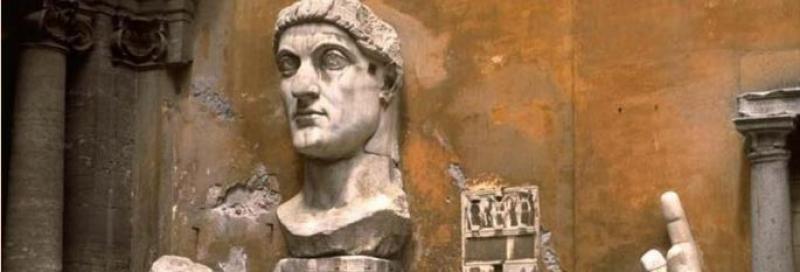The Last Statues of Antiquity edited by R.R.R. Smith and Bryan Ward-Perkins, (OUP, 2016)

The fragments of a colossal statue of Constantine, now in the Musei Capitolini, Rome
Bryan Ward-Perkins discusses the influences behind this book as well as the implications of what it raises.
Access to substantial research grants, and the possibility of collecting large quantities of data digitally, so that it is easily stored and readily searchable, opens up areas of research in the Humanities that could never be tackled by the classic ‘lone scholar’ working with pen and paper, however assiduous he or she might be. In 2009, I and a colleague in Classics, R.R.R. (aka ‘Bert’) Smith, were awarded a large grant by the Arts and Humanities Research Council to study the ‘Last Statues of Antiquity’.
Public statuary, of emperors, grandees and local benefactors, played a major role in the cities of the Roman empire, lubricating the relationship between the city-councils and the important men (and occasionally women) whose goodwill they needed to court. Quite unlike statuary in the modern West, where statues are rare and generally set up to the dead, to serve as cultural and historical symbols, statues in Antiquity played a lively and active role in contemporary politics. An important city, such as Aphrodisias in today’s Turkey, might well have had up to 300 statues standing in its streets and squares, all originally set up to living men and women, and all jostling for attention; while a megalopolis like Rome would have had literally thousands. In ‘Late Antiquity’, the period from around AD 300, the ‘statue habit’ remained important, although increasingly focused on emperors and imperial officials, and produced some spectacular pieces of art (like the late-fifth-century head of the governor Palmatus, from Aphrodisias, who graces the cover of our book). However, the number of new statues erected steadily declined, and the ‘statue habit’ eventually disappeared completely in the early seventh century – the very last statue we know of was set up in Constantinople sometime between 610 and 625. Bert Smith and I realised it would be a fascinating project to study the final phase of ancient statuary, and that between us we had the necessary skills to do this: Bert’s expertise is in the Greek-speaking eastern empire and in Roman statuary, while mine is in the Latin West and in city life.
Having been successful with our application to the AHRC, we were able to employ two admirable researchers to work in Oxford for three years: Ulrich Gehn, to work primarily on the inscribed marble statue-bases, on which our statues once sat and which tell us a great deal about the people commemorated and why they were being honoured, and Julia Lenaghan to work primarily on the surviving statuary itself, much of it reworked material from an earlier period. As so often with a project, the quantity of the data exceeded what we had expected – in the end we documented nearly 900 individual pieces of statuary, nearly 1,700 statue-bases, and over 200 literary references to statues that are now completely lost. All of this material was collected, described and assessed, and mounted in a readily searchable database (often illustrated with multiple photos), that is now freely available worldwide: http://laststatues.classics.ox.ac.uk/. There you can readily discover simple information – such as where statues are known for Justinian’s wife, Theodora – but also make much more complex and recondite searches – for instance, to find out how many statues to praetorian prefects were set up in fourth-century North Africa, and who paid for them.
We are justifiably proud of the Last Statues of Antiquity database, which is extensively used by scholars, students and the wider interested public alike; but we knew we should also put into print the major conclusions of our project, and earlier this year we published the book which is the subject of this short article. It opens with two general chapters, one by Bert and one by me, on how statuary was used in Late Antiquity, before moving on to fifteen chapters surveying the late-antique statue habit across the empire – focused first on broad regions, like ‘Italy’ and ‘Asia Minor’, and then on key cities, such as Rome, Aphrodisias, and Athens. The volume closes with six thematic chapters, covering topics like female statuary and portrait styles, and a final chapter by me on how and why the ancient statue habit eventually died. Seventeen experts, working in eight different countries, contributed to this volume, a testimony to the international nature of modern research collaboration.
There is one feature of the book that is unusual and innovative: many of the foot-notes refer the reader for more information, not to print volumes, but to the Last Statues database. We do this because this database is much more readily accessed than the authoritative corpora that are the usual stuff of foot-notes. Of course, there is a risk and a challenge here: those corpora are safely preserved in print, while the Last Statues database exists only electronically. Will it survive? This is a real challenge for Oxford University, which is creating and hosting more and more databases of this kind, and for the scholarly community at large, which is becoming increasingly dependent upon them. It is a particular challenge for us in the Humanities, because our databases could well be useful for hundreds of years, while our research funding is strictly limited, and currently insufficient for the maintenance, let alone up-dating, of the electronic resources we create, however useful they might be.
The Last Statues of Antiquity is published by Oxford University Press



